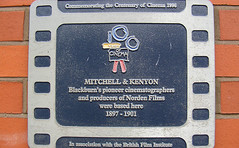Sagar Mitchell
Sagar Mitchell
(1866-1952)
Commemorated on 1 plaque
Centenary Of Cinema 1996 #021
Mitchell & Kenyon Blackburn's pioneering cinematographers and producers of Norden Films were based here 1897-1901
Lord Street, Blackburn, United Kingdom where they worked (1897-1901)

